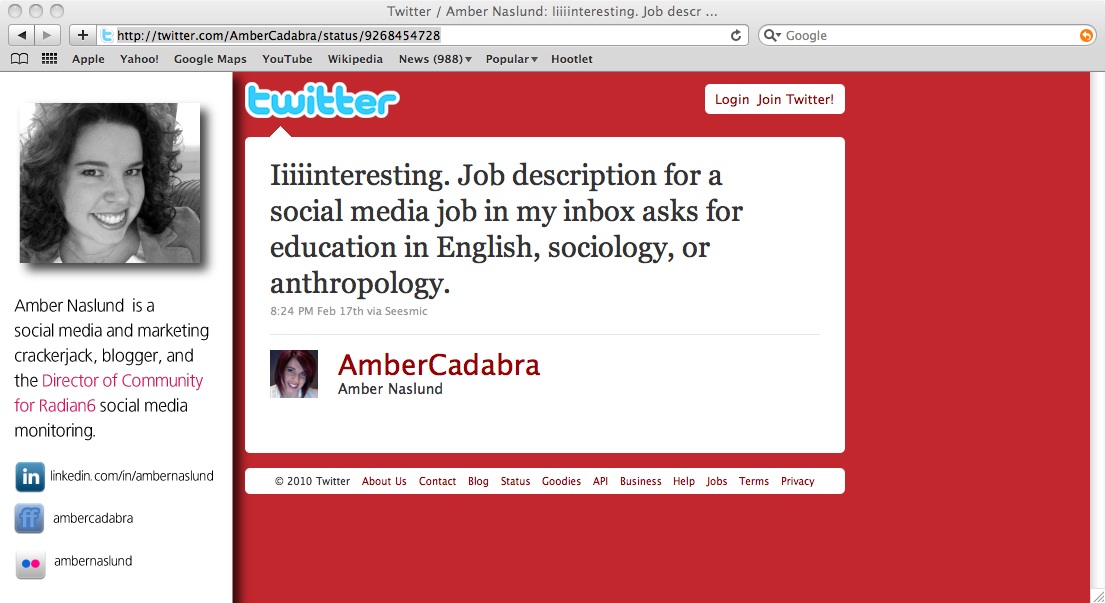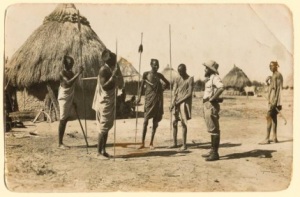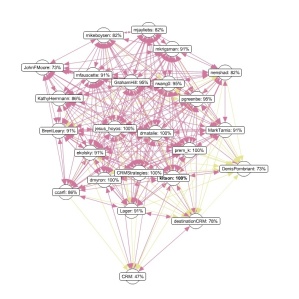In the first post of this series, we talked about listening for what people are saying about you, your brand, your market, your products and services, or market needs that your organization has an answer for. I intentionally didn’t dig into all the things you can do with that data – some are passive and some are active. The important part was listening. Turning that data into actionable insight is where the real magic can happen, but that’s a post for a different day. 😉
A couple of weeks ago, well known social superwoman blogger Amber Naslund sent this surprised tweet out:

It is very interesting indeed. But I think I have a good idea of where that hiring company is going.
Today, I’m going to turn our attention to the second required role for your company: The Social Anthropologist.
I don’t know about you, but when I hear that phrase, it immediately brings to mind sleepy images of some British guy talking slowly and methodically on a Sunday afternoon about some displaced nomads in the bush of Botswana.

But that’s not what I am talking about here. I’ve said it once and I’ll say it again. Know your customer.
Today, most companies are doing a good job of profiling their customers based on transactional data.
(1) Who spent the most money with us this year?
(2) Who is forecasted to spend more money with us next year?
(3) What net new opportunities do we have?
We may be breaking this data down by region, SIC Code, etc. We may have history of our marketing campaigns, response rates, phone calls, web form submissions, email interactions, sales person’s notes. We’ve got it all; Mounds and mounds of data about our customers.
With all this data, we may think we know our customers. But we don’t. In fact, we know very little about them.
A more complete customer profile
Harvey Mackay set out decades ago with his Mackay 66 to learn more about his customers. It was a differentiator. This was the next step towards actually knowing our customers. Do something like this, and you’ll be heads and shoulders above most of your competition.
But what if we were to take it even one step further?
What if we were to not just know about our customers, but also about the groups of people that they were part of, who they interact with, how they interact, and why?
Wikipedia defines Social Anthropology the following way:
Social anthropology is the branch of anthropology that studies how contemporary living human beings behave in social groups.
Practitioners of social anthropology investigate… the social organization of a particular people: customs, economic and political organization, law and conflict resolution, patterns of consumption and exchange, kinship and family structure, gender relations, childrearing and socialization, religion, and so on.
Most of our customers don’t live on an island (unless they live in Hawaii, or Australia, or… Suwarrow). No, I’m not talking about that kind of island anyway.
Strive to learn about your customers (and prospects) in the context of their lives.
They (We) all have circles of friendships, professional relationships, patterns, etc. that we live by. We have patterns of decision making, and we all make decisions based on influence of those we know and trust.
Below is an example of the #scrm Accidental Community on Twiangulate compliments of Josh Weinberger
By understanding more about those who influence our customer’s decisions; who they interact with, how they interact, and why they interact, we may discover valuable insights that may help us to meet our customer’s needs better, and if your organization is prepared enough, even co-create solutions with them.
Conversely, we may also begin to understand who our customers influence, and why a successful sale might not only allow us to recognize revenue from that single purchase, but also a chain of purchases based on the influence and recommendation of our customer’s purchase decision.
These insights are not only valuable for each individual prospect or customer, but also in aggregate. By profiling groups or segments of our customer base (or our target market in general), we can potentially gain key insights into who is likely deriving the most value from our products and service offerings.
The internet is compiling a huge amount of data
Feed.ly knows that 65% of my facebook friends are male, their most popular music group is U2, and their most popular movie is Gladiator.
While this may not present immediate opportunity in your mind, the point is illustrated. By knowing who I talk to, what their interests are, when and how we communicate, there are numerous opportunities to know more about me, what my preferences are, and what opportunities exist to help me in my daily life.
IBM recently did a social network analysis project called SNAzzy , to accurately chart and predict lifetime customer value and churn rates in the telecommunications industry.
James Koblieus points out on his blog the huge impact social network analysis will have on data warehouse growth and there are plenty of other challenges that await us as we begin to analyze and make sense of this data, and integrate with our existing systems and processes.
This is a new area for me and something I’ll definitely be spending more time on. If you know of any additional resources, please send them over.
Your customers and prospects are sharing, talking, conversing, and transacting. Get to know them. Partner with them, and find more people like them.
Comments
Trackbacks
-
Your article was most tweeted by CRM experts in the Twitterverse…
Come see other top popular articles surfaced by CRM experts!…
-
Your article was most tweeted by Customer Service experts in the Twitterverse…
Come see other top popular articles surfaced by Customer Service experts!…
-
[…] The Social Anthropologist, which highlighted a rapidly growing requirement for a skill set that has previously been relegated […]
-
[…] (2) The Social Anthropologist, which highlighted a rapidly growing requirement for a skill set that has previously been relegated to studies of remote people groups, but now has potential ground breaking applications for forward looking organizations. Know your customers (and their network). […]
-
[…] The Social Anthropologist, which highlighted a rapidly growing requirement for a skill set that has previously been relegated to studies of remote people groups, but now has potential ground breaking applications for forward looking organizations. Know your customers (and their network). […]
-
[…] anthropologist and Director of Marketing may seem to be world’s apart, they’re not. Here’s a link to an article I wrote highlighting why it might be the perfect […]
-
[…] anthropologist and Director of Marketing may seem to be world’s apart, they’re not. Here’s a link to an article I wrote highlighting why it might be the perfect […]


Brian,
Your article is timely and reminds me of two recent, although slightly tangent, convos. One was with Venessa Miemis where we both made predictions of an expected rise in humanities-based majors gaining more prominence in business.
In another, Blake Landau, Jo’Ann Alderson, Judy McKee and I also recently shared a panel discussion on customer service. And Blake just blogged about part of the convo regarding creating a “thinking customer service department.”
Partial achievement of such a thinking contact center approach dovetails with your thought leadership on business-based anthropologists.
If more service reps were taught (inspired?) to think like anthropologists, they’d be more effective in drawing out information from the customers they engage with. It’s a combination of hearing what is and isn’t said and the keywords used in the process. Then taking that information to diagnose the problem and supply effective resolutions to help customers.
Kathy, good point. While the nature of my post was mostly about gathering and analyzing data through social network analytics, simply changing the mindsets of those who interface with customers and prospects would also potentially help to gain a deeper understanding of our customers and prospects.
Excellent Job!
I agree so much with what you said, I wish i could write that well and say that.
Ha! Thanks E. But come on, I expect better than that from you. 🙂
Hi Brian –
Nicely done here. I dearly love all the discussion about finding data and insights on your customers, and using that information to better your products and services.
There’s one thing I’m passionate about, though, and that’s something the data cannot help you with. It’s *intent*, and it’s the idea that you actually *care* about getting to know your customers because you want them to have a positive experience. Not because it does good things to your numbers. Not because the data says so. But because you care, at a root level, that you do well by them.
The sCRM discussion is a good one, as is stuff about the humanities and anthropology. But what I’m so hungry for is to express the need for businesses to turn on their empathy – which is sometimes messy, imperfect, and not trackable – as well as their analysis in order to build better relationships with their customers.
Thanks for continuing the discussion.
Cheers,
Amber
Amber,
Two things to counter your comments:
1) Intent is not getting to know your customers to want them to have a good experience. Intent, as part of the knowledge trilogy of Content, Context, and Intent, actually serves the purpose of properly framing the need for the information. Intent is what actually decodes for the company the real reason the customer wants something, and provides the company with needs-and-wants data they cannot get otherwise. It is obtained through analytics, inference of other data, and the direct questioning. A very simple example, if a customer is looking at their balance in a banking application, a company that looked at content would simply provide the balance, a company that looked at context also would provide the balance and some additional services, and a company that looked at intent would know that the customer is trying to buy a home and would provide the customer with mortgage and related information. Intent is not about caring for the customer, is about optimizing the knowledge and services offered to maximize the return on that same customer.
And that brings me to the second point,
2) Businesses are not now, nor will they ever be empathetic. Business are entities with no emotions (empathy is a human emotion) or feelings. they have specific goals to accomplish, and even if the people within their ranks were to become empathetic towards customers, they will still have to deal with specific guidelines and rules on what they can and cannot do. Trying to ascribe emotions and feelings (and even relationships) to businesses is asinine and a sure way for customers to get their expectations shot to bits. As long as customers understand the main driving force of business as a profit-making entity, and they are willing to sacrifice some of their short term profit in exchange for longer-term higher profits (not the same), then there is a change to have a win-win situation between them. If the customer insists in getting what they want without regards to the needs of the business — there is a problem.
One of my main concerns about social media is that is giving customers the fake idea that they can violate the core law of win-win for businesses and their customers, and tilt the balance in their favor. Although some businesses have responded poorly to the customer yielding the megaphone, I am certain that in the long run there is not going to be sentiments or feelings towards customers, just focus on their goals and objectives.
The discussion will be advanced when the customers realize that businesses also need to have a win situation, not just giving in to customers with megaphones.
Thanks for listening… flame away 🙂
Amber,
Thanks so much for stopping by and sharing your thoughts. Though we’ve never met, I have a tremendous amount of respect for you and there is a reason why you have so many fans and followers in the social sphere. It’s because you clearly do care and have a tremendous skill at expressing your humanness, your vulnerabilities, your empathy, and especially your talent.
There is wisdom and beauty in the passion you exude and champion.
You bring up, however, a point that I think is a great topic for debate.
Your assertion assumes a few things:
1. Customers want a relationship with you
2. The “customer” needs and/or wants empathy and care
3. That this empathy and care is good for business
At the end of the day, this is business. The purpose of business is to make a profit.
I know plenty of customers who are concerned about one thing: Results. This is generally measured by return on their investment. While all the touchy feely stuff is nice, and I do believe it does make some impact on long term business, it pales in comparison to the real need of maximizing value for the customer – helping them accomplish their goals.
Customers are less loyal than ever, and they have more options than ever before. They’ll jump in a second if the value offering is better somewhere else.
Customers are generally ruthless in negotiation, and want as much as they can get for the smallest amount of investment.
Business is competitive. We are all constantly put to the challenge of creating and providing more and more value with fewer resources to do so.
The key is knowing your customer, and maximizing your value offering to them. Caring and empathy are great, but let’s also remember not to misunderstand our customer’s *intent*.
Hi Brian,
This reminds me of a scene in ‘Alice’s Adventures in Wonderland’ where the Caterpillar asks Alice who she is:
—
`Who are you?’ said the Caterpillar.
This was not an encouraging opening for a conversation. Alice replied, rather shyly, `I–I hardly know, sir, just at present– at least I know who I WAS when I got up this morning, but I think I must have been changed several times since then.’
`What do you mean by that?’ said the Caterpillar sternly. `Explain yourself!’
`I can’t explain myself, I’m afraid, sir’ said Alice, `because I’m not myself, you see.’
—
For a seemingly simple question, it’s quite difficult to explain who we are, especially in contexts of a 1-on-1 interview or a focus group in a sterile facility.
Therefore, it’s increasingly seen as a smarter decision for us researchers to go where people feel more comfortable – and often opening up about themselves (without consciously thinking about it).
Social media is an incredibly rich source that allows us to see into customers’ lives without having to plant ourselves in their homes for weeks at a time. Plus, we can delve more into subjects that customers take for granted, yet contantly ‘perform’ online (check out Judith Butler or Stuart Hall for some great insights on performing identities).
So rather than asking Alice who she is, we can now look at her Facebook page to see what she has been eating and what tea parties she will be attending and with whom as well as observe her actions prior to any croquet matches or her behaviour post-tea party.
Peter
I was thinking about this last night as I signed up for a membership with 24-hour fitness. My sister joined a week earlier and was essentially the influencer in my decision to start shelling out $40 a month in membership fees. Before she mentioned she was joining I hadn’t given it a first or second thought. But once she joined, I became what a sales-person might call “low hanging fruit”. Any my husband is next in line – teetering on the precipice.
So the question I was pondering over as I ran 2 miles last night, was how does a business go about identifying such individuals, this segment of “low hanging fruit” that could just as easily join as not join? Nothing about my facebook page or my LinkedIn page suggests I was considering joining a gym (though it does say I am the mother of a 1 year old – so perhaps all the weight-loss banner advertising may have had some impact on my decision)! But I guess what I’m getting at, is trying to picture how an entity like 24-hour fitness can find me – using social media? They have my sister’s name, address and email but how does that help them find me or even identify her as an influencer?
Maybe I’m oversimplifying this but since my sister joined, she has started a marketing chain that goes 6-8 people deep. Given the minimal investment needed from 24-hour fitness to convert these potentials to confirmed sales (and potential new influencers), how can social media close the gap?